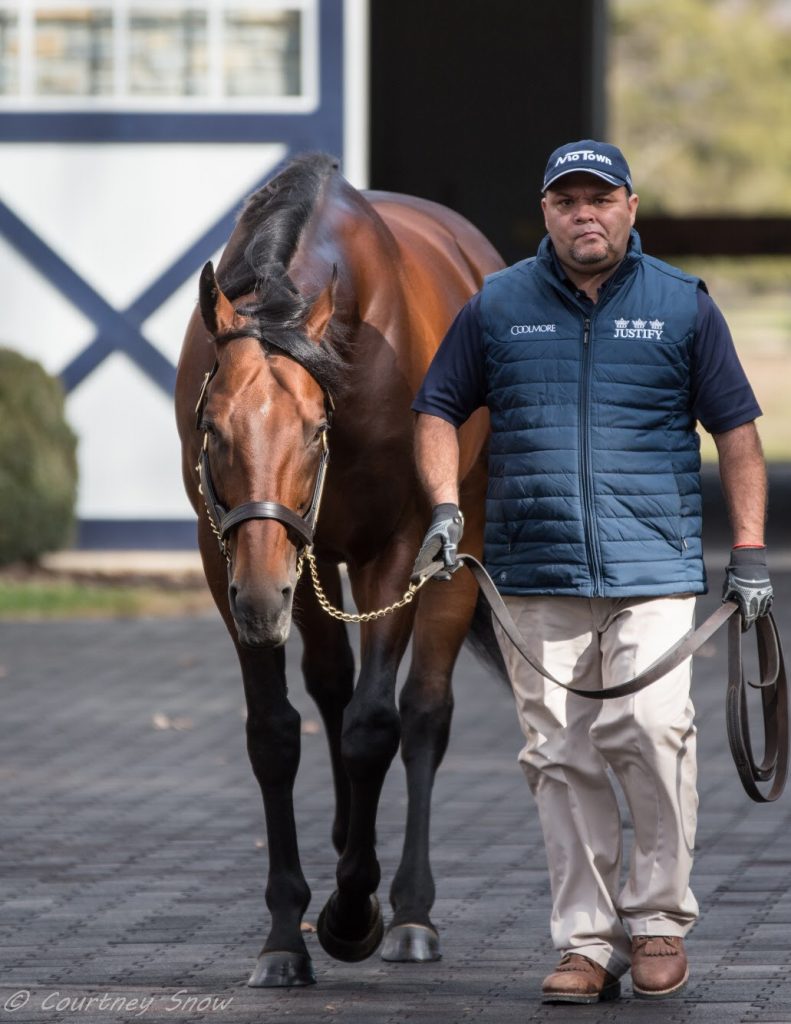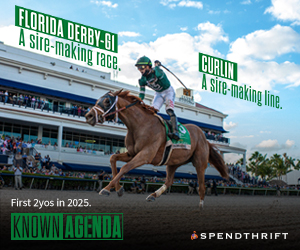
American Pharoah- Courtney Snow
Steve Zorn
In the wake of a thoroughbred yearling sales season that has seen average and median prices decline by double-digit margins, most of the major stallion farms have announced their stud fees for 2021. Not surprisingly, the trend is downward. But the question for breeders will be: are the reductions enough to justify going forward for another year?
With virtually all the major US stallions accounted for, I took a look at all 72 horses with fees of $15,000 or more for next year, the stallions whose progeny make up most of the middle and upper market at the auctions. There are 72 of those, ranging from the new alpha male, Into Mischief, with a $225,000 fee, down to a group of 16 listed for $15,000. Of the 72, only seven will have their fees increased for next year, while 44 will have lower fees. Fees remain the same for only 21.
Aside from Into Mischief, who tops this year’s Blood-Horse’s list of North American sires with progeny earnings of over $14 million, the others defying the downward trend are Uncle Mo (whose stud fee will be raised from $125,000 to $175,000 next year), Speightstown ($70,000 to $90,000), Munnings ($30,000 to $40,000), Constitution ($40,000 to $85,000!), Nyquist ($40,000 to $75,000) and Not This Time ($12,500 to $40,000, on the strength of California filly Princess Noor).
The average decrease in the fee of the 44 stallions whose fees are dropping is about 25%. That’s pretty much in line with the decrease we’ve seen so far this year in the two-year-old-in-training sales and the more recent yearling auctions. For breeders, however, the stud fee is only part of their costs; there’s also the expense of maintaining the mare and raising the foal until it’s ready for the race track or the sales ring. Those other costs aren’t going to get any lower, so the stud-fee reductions, while they’ll help, may not be enough to restore profitability, especially for stallions whose stud fees are toward the lower end of the range, where other costs are a bigger proportion of a breeder’s total expenses.
Looking at those horses whose fees dropped by more than the average, the biggest dollar amount is War Front, from $250,000 this year to $150,000 in 2021, ceding the top of the standings to Into Mischief. Other notable decreases include American Pharoah (from $175,000 to $100,000), Malibu Moon ($60,000 to $35,000), Gun Runner ($70,000 to $50,000), and Frosted ($40,000 to $25,000). And the decreases didn’t spare even those sires ranked in the top 20 by progeny earnings; seven of those – Tapit, Candy Ride, Hard Spun, Kitten’s Joy, Street Sense, More Than Ready and Goldencents – have had their fees reduced for next year.
Stallions often see a decrease in popularity in their third and fourth years at stud, when potential buyers have seen some of their offspring in the sales ring or on the racetrack, and when even newer stallions take over the limelight as the next big thing. Of the 10 horses with fees of $15,000 or more that will be entering their third season at stud in 2021, seven had their fees decreased, while three stayed the same. And of the seven entering their fourth year at stud, with yearlings already through the sales, four had their fees decreased while three stayed the same. Not a single new stallion saw a stud fee increase. But breeders will almost certainly head to the new kids on the block for 2021, including Kentucky transplants Daredevil, recalled from exile in Turkey, and Laoban, promoted from New York. Newcomers will include Game Winner ($30,000 at Lane’s End), Improbable ($40,000 at WinStar), McKinzie ($30,000 at Gainesway) and Maximum Security (a fee yet to be determined, at Coolmore’s Ashford Stud). And we can expect some of those third- and fourth-year stallions to be leaving Kentucky for regional markets or foreign stud farms not too long from now.
Fees at the top of the market aren’t at the insane heights they once were, when Storm Cat fetched half a million dollars for every appointment in the breeding shed. But with seven Kentucky stallions listed at $150,000 or more for next year, they’re still not cheap. For the most part, the horses at the top of the stud-fee list are long-established, well-proven sires. Their owners have long since made back whatever they may have spent to acquire the breeding rights. And they’re grandfathered in under the new Jockey Club rule that will limit stallions born in 2020 or later to 140 mares per year. According to the Jockey Club Fact Book, more than 40 stallions were bred to 140 or more mares each last year, representing a startling reduction in genetic diversity when compared to the old days when stallion “books” were limited to 40 mares. So, if the owners of those top-of-the-market sires reduced their fees even further, they could make their horses work even harder and cover more mares. Whether that would be good for racing – and for the general health and well-being of their progeny – is another question.
In general, it appears that the stallion market is responding to the signals that this year’s sales have sent. Whether it’s enough to reverse the steady decline in the size of the North American foal crop is something we’ll learn in the next few years.



